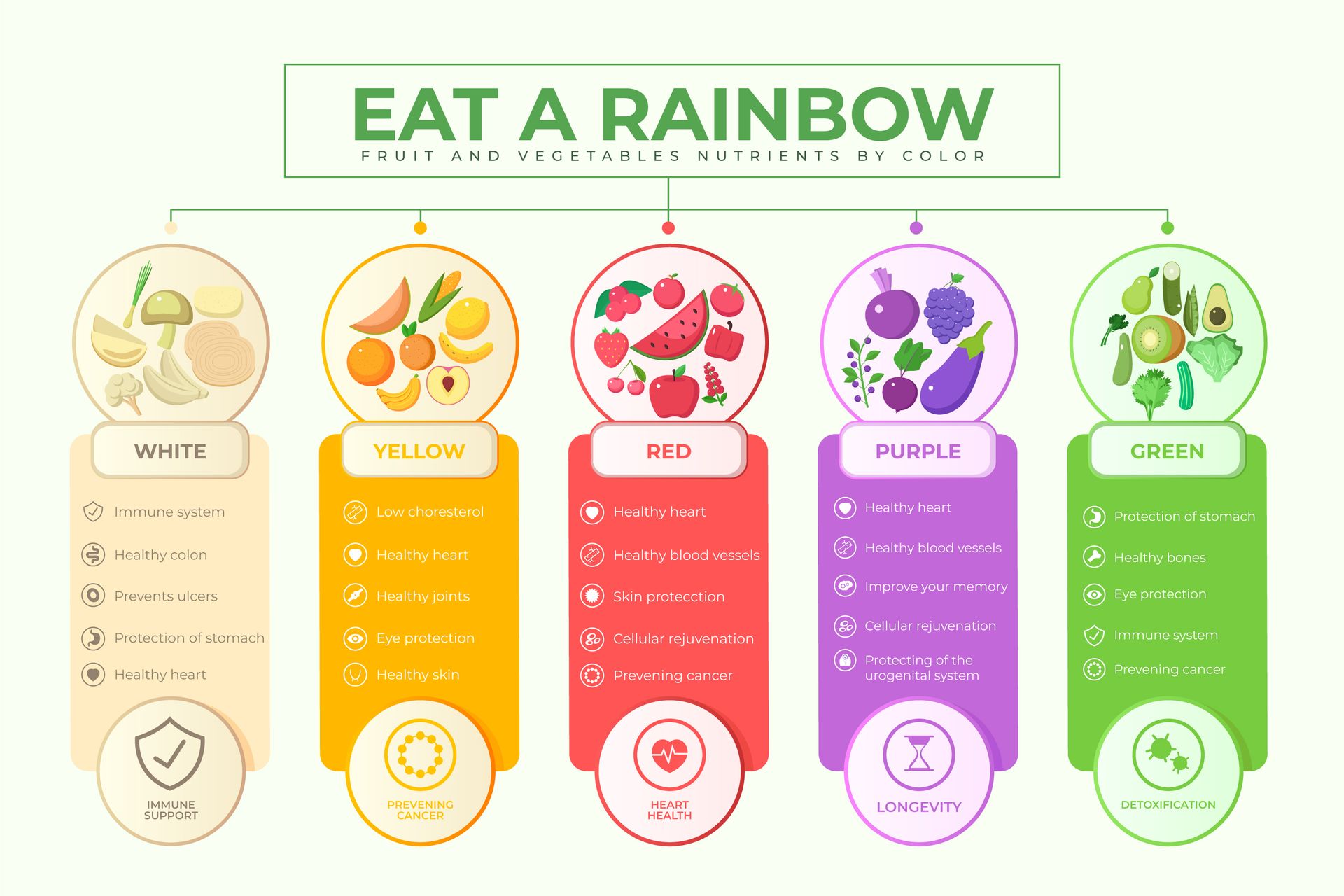Each color represents different nutrients that benefit the body in unique ways. Challenge your kids to “eat the rainbow” by including foods of different colors on your child’s plate throughout the day or week.
Understanding Pediatric Nutrition: Building Healthy Eating Habits

Raising a child is full of exciting milestones—first steps, first words, and, yes, even their first picky eating phase! But as fun (and sometimes challenging) as these moments are, one thing nobody should overlook is nutrition.
Why? Because what your child eats today lays the foundation for their growth, learning, and long-term health.
A child's nutritional needs are different from those of adults. Their bodies are rapidly changing, and the foods they consume directly fuel everything from brain function to bone strength. Without the right fuel, it can lead to problems later in life, like obesity, diabetes, or nutrient deficiencies.
Let
Sang Pediatrics guide you with our expert pediatric nutrition advice and empower you to cultivate sustainable, healthy eating habits for your child. Whether you have a picky eater, a teen athlete, or anything in between, you'll walk away with the know-how to nourish your child's body and mind.
Get the Expert Co-pilot in Your Kid’s Nutrition
Nutritional Needs by Age Group
A child's nutritional requirements can vary quite a bit depending on their stage of growth and development. Here's a quick breakdown of the key dietary needs for different age groups:
| Infants (0-12 months) | Breast milk or formula should serve as the main source of nutrition. Iron, zinc, and vitamin D are critical for proper growth and immune function. Avoid added sugars, salt, and cow's milk during the first year. |
|---|---|
| Toddlers (1-3 years) | Continue breastfeeding or offer whole milk. Provide a diverse selection of fruits, vegetables, whole grains, lean proteins, and healthy fats. Limit juice, sugary snacks, and processed foods. |
| Preschoolers (3-5 years) | Focus on nutrient-dense foods like eggs, beans, nut butter, and leafy greens. Encourage water over juice or sugary drinks. Portion sizes should be age-appropriate (e.g., 1/2 cup fruit and 1/4 cup veggies). |
| School-Age (6-12 years) | Calcium, vitamin D, and protein become increasingly important. Majority of the diet should consist of whole, minimally processed foods. Support kids develop a positive relationship with food and physical activity. |
| Teens (13-18 years) | Needs for calories, protein, calcium, and iron significantly increase Support growth spurts and athletic activity with balanced, nutrient-rich meals. Encourage autonomy around healthy food choices. |
Regardless of age, it's always a good idea to consult your pediatrician to ensure your child meets their unique nutritional requirements.
Building Healthy Eating Habits Early
Fostering nutritious eating habits isn't just about what's on the plate—it's about creating positive relationships with food that last a lifetime.
Start at Home: Always lead by example since children often mirror their parents’ eating behaviors.
- Instead of reaching for chips, go for veggies and fruits.
- Make family meals a priority—eating together encourages healthier choices for everyone.
Make it Fun and Interactive: Let your kids participate in meal prep and grocery shopping.
- Stirring, arranging, or even picking out recipes can make healthy eating more exciting.
- Create colorful plates using different fruits and vegetables.
- Give foods fun names ("dinosaur trees" for broccoli).
Set Regular Meal Times: Stick to regular meal and snack times.
- A predictable schedule helps prevent constant grazing or skipping meals.
- Limit distractions like screens during meals so they can focus on their food.
Avoid Pitfalls: Skip the following practices as they might cause unhealthy habits in the long run:
- Using food as a reward or punishment
- Forcing children to clear their plates
- Completely restricting certain foods
- Making separate meals for picky eaters
Empower Your Child: Give your child some control over their food choices. For example:
- Offer two healthy options (“Do you want apples or bananas for your snack?”).
- Let them help create a meal plan or choose a new vegetable at the store.
Healthy habits start with small, consistent steps. You don’t have to aim for perfection—just progress!
Common Challenges and Solutions
Now that we've covered healthy eating habits and practices to avoid let's tackle some real-world challenges that parents often face.
"My child only wants to eat chicken nuggets and mac & cheese!"
Solutions:
✓ Involve them in meal planning and preparation
✓ Present new foods alongside familiar favorites
✓ Make food fun with creative presentations
✓ Be patient. It may take
10-15 exposures for a child to accept a new food
"Between work and activities, we barely have time for proper meals!"
Solutions:
✓ Prep ingredients or meals during weekend downtime
✓ Keep healthy grab-and-go options available
✓ Create a weekly meal plan to reduce decision fatigue
✓ Include simple, 15-minute meal options in your rotation
✓ Stock up on nutritious frozen vegetables and pre-cut fruits
"My child won't eat without watching videos!"
Solutions:
✓ Establish a "device-free dining" policy for the whole family
✓ Create engaging mealtime conversations
✓ Use special placemats or fun plates to maintain interest
✓ Start with one screen-free meal and gradually increase
"Healthy food seems so expensive!"
Solutions:
✓ Buy seasonal produce
✓ Choose frozen fruits and vegetables
✓ Plan meals around sale items
✓ Buy in bulk for frequently used items
✓ Start a small herb garden for fresh flavors
"My child snacks all day and won't eat meals!"
Solutions:
✓ Create a consistent meal and snack schedule
✓ Offer protein-rich snacks that satisfy longer
✓ Keep set snack times (2-3 hours before meals)
✓ Make water the go-to between meals
✓ Avoid grazing by closing the "kitchen" between meals
Your Partner in Raising Healthy, Happy Eaters

Even with the best intentions, some nutrition challenges require a little extra help.
Key Signs It’s Time to Consult a Professional:
- Your child's growth patterns change unexpectedly
- Mealtimes become a source of family stress
- You notice significant changes in eating habits
- Questions about nutrient deficiencies arise
- You need personalized dietary guidance
Seeking professional help isn't a sign of failure – it's a smart step toward your child's optimal health. At Sang Pediatrics, we're committed to transforming stressful mealtimes into enjoyable family moments.
- Personalized Nutrition Consultations:
Every child and their nutritional needs are unique. Your child will receive balanced and enjoyable meals delivered by our team that fit seamlessly into your family's lifestyle.
- Comprehensive Wellness Check-Ups: During these visits, we:
- Assess your child's nutritional status
- Discuss current dietary habits
- Provide practical guidance for maintaining a healthy diet
- Address specific concerns and questions
- Create achievable goals together
Every bite your child takes is an investment in their future. The path to establishing healthy eating habits doesn't demand perfection—it thrives on consistency and support.
Ready to transform your family's relationship with food? Take the first step today. Visit us at our
walk-in clinic in Fresno or schedule an online consultation with our team at Sang Pediatrics. Let's work together to give your child the gift of lifelong healthy eating habits.
Looking for the Secret Ingredient to Happier Mealtimes?











